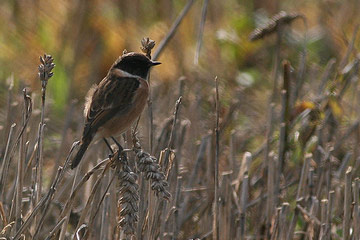
Stonechat © Peter Twist
Many Stonechats are strongly territorial in pairs throughout the winter, either enlarging the breeding territory by a factor of two or three, to ensure the availability of sufficient food, or establishing new winter territories, many of which are coastal and may be totally unsuitable as nesting habitat (Migration Atlas). As an early breeding species, many males are singing in January and most birds have staked their territorial claim before the end of February, so some of the mapped ‘winter’ records will be from breeding birds. In fact, only three of the tetrads with a breeding season record were not also occupied during winter.
The Cheshire and Wirral breeding birds cannot, however, account for all of the Stonechats present in the county during winter. The BTO Winter Atlas text, based mostly on experiences in the Channel Islands, misleadingly emphasises the sedentary nature of the species. The Stonechat has evolved as a partial migrant to guarantee survival of at least a proportion of the population in the event of either migratory or winter catastrophes, and many of the birds found here in winter must have moved in from breeding areas elsewhere. There is no indication of Stonechats wintering here from anywhere outside Britain. The main stronghold of the species within Britain is in north-western Scotland, relatively few of those birds remaining for the winter, with some of them known to have migrated south as far as Spain and Portugal (Migration Atlas). Cumbrian-bred birds have been proven to winter in Kent. So, the likely origin of many of the birds wintering in Cheshire and Wirral is northern Britain. A fascinating challenge for the county’s ringers would be to test this suggestion.
The Atlas map shows that there are three main components to the Cheshire Wirral wintering population. Some birds visit the coast; others tough it out in the eastern hills; while a third group follows the lines of rivers, especially the Mersey and the Gowy. All of these areas provide the rough ground that the Stonechat needs, and perhaps the recent habitat improvements in the Gowy corridor – particularly aimed at Barn Owl conservation – have incidentally benefited wintering Stonechats. A wide variety of habitat codes was recorded, with 44% on farmland (mainly grassland and low hedges), 31% semi-natural grassland and marsh (mostly wet areas, grazing marsh, reedbeds and saltmarsh), 8% scrub and 5% bog.
As in the breeding season, their main food is invertebrates, spotted by watching from a perch and taken from the ground. They require a certain warmth for their prey to be active, and the winter distribution of Stonechats nationally is more or less bounded by the 4º C January mean isotherm. All parts of the county comfortably exceeded that criterion, although eastern Cheshire was a little colder than that in January 2006. When their favoured insect prey is scarce, or hard to find, Stonechats occasionally take berries and they can survive for a few days on a vegetable diet.
Coward and Oldham (1910) quoted Brockholes (1874) that Stonechat was ‘a partial migrant, a few remaining all winter’, and they knew a few winter records themselves. Boyd (1951), writing about the Great Budworth area, stated that it is ‘distinctly uncommon and has been seen only 13 times in 40 years, as a winter visitor’. Bell (1962) added that, as a winter visitor it has been seen ‘in most of the last 10 years around West Kirby and Hoylake, and in the Frodsham area’. All of these writers indicate the species’ relative scarcity.
In this Atlas survey, although fieldworkers were not required to submit records from the same tetrad in more than one winter, in fact for this species some observers did so, giving useful indications of recurrence at wintering sites: records were submitted from 91 tetrads for just one winter, from 27 tetrads for two winters and from 2 tetrads for all three winters. Most surveyors also gave counts of the Stonechats seen. For the three winters of this survey, 2004/05 to 2006/07, there were Stonechat records from 57, 48 and 58 tetrads, with totals of 107, 84 and 117 birds. It may not be a coincidence that January 2006 was the coldest of the three years.
These are the largest numbers of Stonechats known to have been wintering in the county since ornithological recording began.
Sponsored by Irene Blagden

